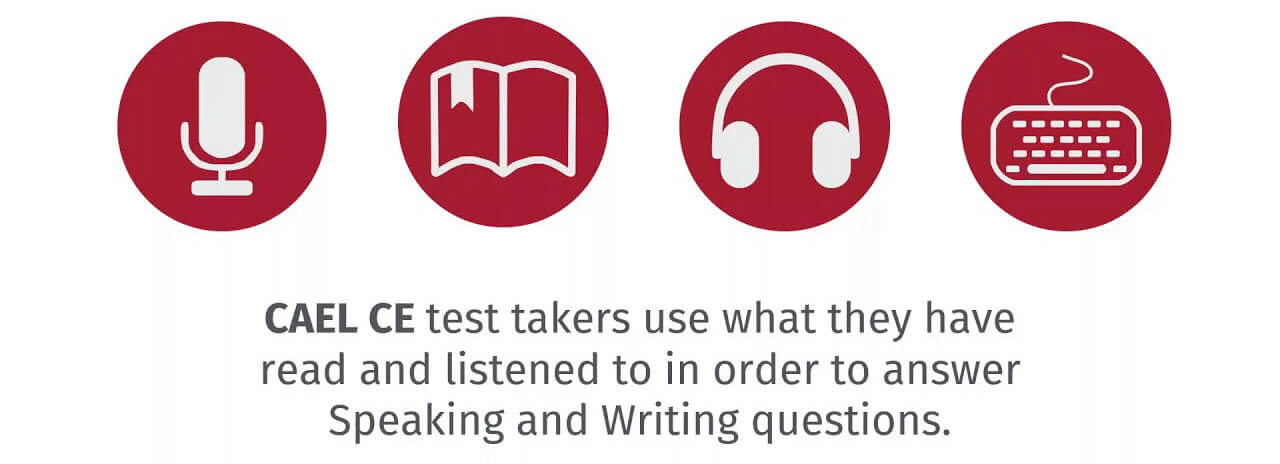This test is designed to measure the English language proficiency of students planning to study in Canadian post-secondary institutions. CAEL is one of the best tools for identifying students with the right English skills for academic success. It provides an authentic representation of language use in a Canadian academic context. Test takers read articles, listen to a lecture, answer questions, and write a short essay, as they would be expected to do in a first-year Canadian university or college classroom.

CAEL is now available as a computer-delivered test, known as CAEL CE (Computer Edition). CAEL CE has been improved to deliver all four components (reading, listening, writing, and speaking) by computer in a single test sitting. The total allotted test time is approximately 145 minutes (2 hours and 25 minutes). Some test centres offer the CAEL Assessment over 2 days, with the Written Assessment and the OLT held on separate days. The CAEL Assessment has two parts: Part 1, the Written Assessment and Part 2, the Oral Language Test (OLT).

|
|
25 minutes |
| Listening Section | 20 minutes |
| Reading Section 2 | 30 minutes |
| Writing Section | 45 minutes |
The time allotted for the Reading section is 55 minutes. Test takers are given two readings that are on the same topic as the Listening and Writing components. The readings are taken from the following sources:
Reading Tasks Include:
The time allotted for the Listening section is 20 minutes. Test takers listen to a pre-recorded lecture and answer relevant questions on the same topic as the Reading and Writing components
Listening Tasks Include:
The time allotted for the Writing section 45 minutes. Test takers will use the information from the Reading and Listening components to write a short essay. It is encouraged that test takers plan their essays prior to writing.
The essay topic asks the test taker to:
The time allotted for the Oral Language Test (OLT) is 25 minutes. The OLT is carried out on a computer equipped with a headset and microphone, however test takers will not be required to use the computer mouse or keyboard. The OLT may be taken before or after the Written Assessment. It consists of five tasks which sample typified and recurring speech acts within college and university settings:
| Task 1 (2 minutes) | Make a short oral presentation. Test takers are given the topic for the presentation upon registration in stage one and may take as much time as they like to prepare and practice their talk in advance of the test. |
| Task 2 (5 minutes) | Relay information obtained from a lecture. Test takers are asked to provide key information to another student based on their understanding of a short recorded segment of a professor’s instructions. |
| Task 3 (5 minutes) | Relay information obtained from an academic document. Test takers are asked to provide specific information based on their reading of a short, generic academic document. |
| Task 4 (5 minutes) | Relay information from an academic text. Test takers are asked to read a section of the text in Task 3 aloud, for the purpose of discussing the text in the context of a group discussion or academic presentation. |
| Task 5 (8 minutes) | Explain a choice for participation in a group project. Test takers listen to a professor’s instructions for a group oral presentation. Then they listen to other members of a group who explain their preferences for participation in the presentation. After listening to the other group members, the test takers are asked to explain their own presentation choice and ask a question regarding an important detail related to the presentation (e.g., time allowed, marking criteria, available equipment, etc.). |
CAEL Assessment Scores are reported for Listening, Reading, Writing, and Speaking test components. The scores range from band level 10 to band level 90.
Each band score corresponds to a descriptive statement summarizing the level of English language proficiency of a test taker.
| 80-90 | Expert: demonstrates a level of competence, accuracy, and effectiveness in academic/professional settings |
| 70 | Adept: uses generally accurate language in most settings; some limitations in flexibility are evident |
| 60 | Advanced: displays competence in academic or professional settings |
| 50 | High Intermediate: exhibits some competence in academic or professional settings; communication may break down in places |
| 40 | Intermediate: demonstrates some ability to comprehend and articulate complex ideas and arguments typical of academic or professional settings |
| 30 | High Beginner: expresses basic ideas about familiar topics in routine settings |
| 10-20 | Low Beginner: communicates with limited ability |
| 70-90 | Meets university and college entry requirements |
|---|---|
| 50-60 | May meet entry requirements at some colleges and universities |
| 10-40 | Too low to meet entry requirements at any college or university |
1.) Results of tests taken at Canadian test centres are available within 10 to 15 business days after the scheduled test date. However, the results of tests taken at international test locations are available within 20 business days after the scheduled test date.
2.) Test takers’ test scores can be sent to five institutions, which is included in the registration fee. Institution details are provided by the test takers when registering online, or up to 4 days before the chosen test date. The official score reports will only be mailed to academic and professional institutions






















Crossland Education & Careers
SCO 85, near Mangaldeep, Bridge Market, 17C, Sector 17, Chandigarh
Call: 090717 75577